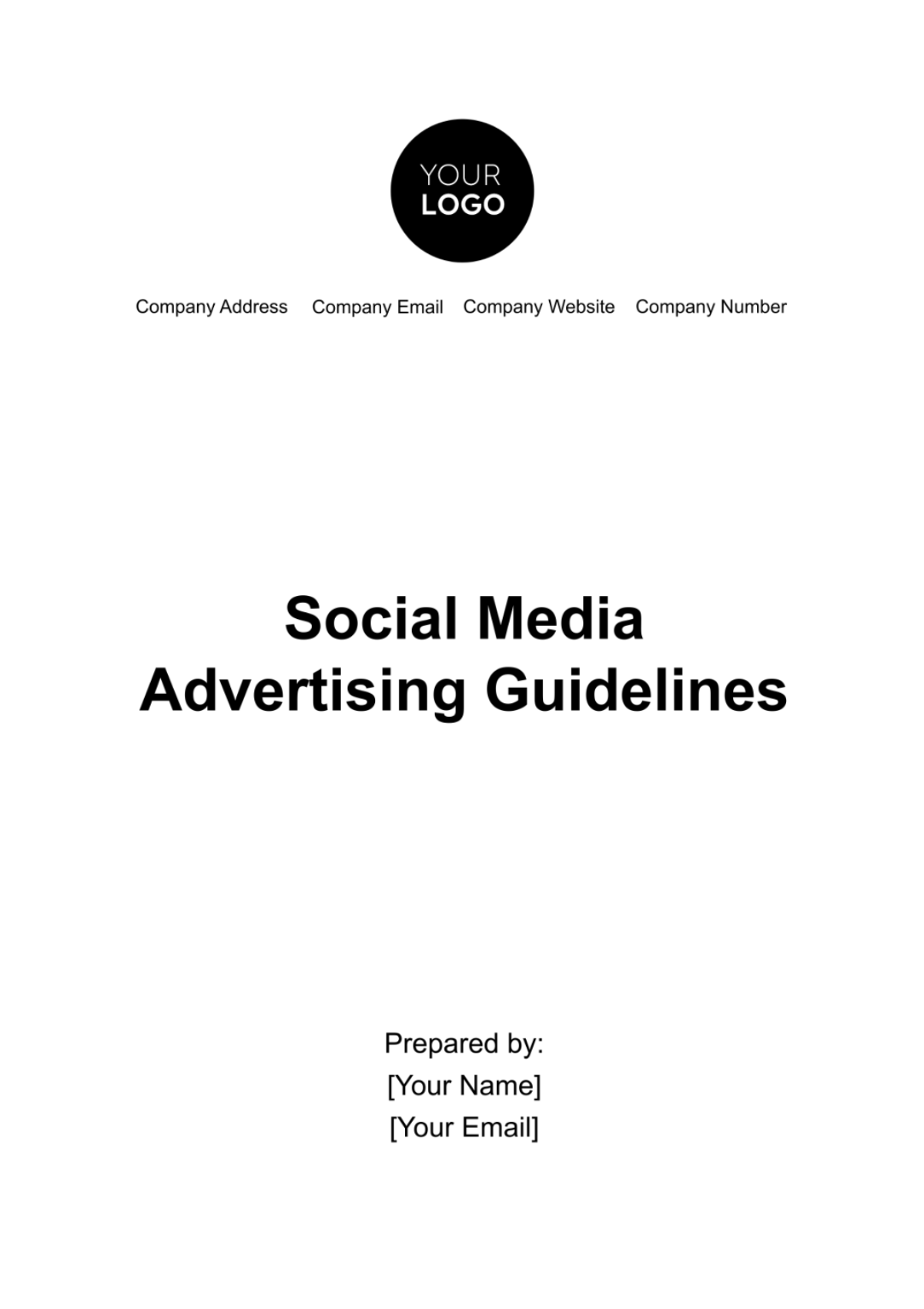Free Social Media Advertising Guidelines

Introduction
This document addresses a broad spectrum of topics, from crafting impactful advertising strategies to managing online engagement. These guidelines aim to equip businesses with the necessary knowledge and tools to successfully navigate the complexities of social media advertising, ensuring a proactive and well-prepared approach in all aspects of their digital marketing endeavors.
Understanding Our Brand
Before embarking on any social media advertising campaign, it's paramount to cultivate a profound understanding of our brand, its core values, unique selling propositions (USPs), and voice. Ensure that all ad campaigns are a faithful reflection of our brand's identity, mission, and visual aesthetics.
Brand Identity Table
Element | Description |
Core Values | List our brand's fundamental principles and beliefs. |
Unique Selling Proposition | Identify what sets us apart from competitors. |
Brand Voice | Define the tone and style of communication. |
Visual Aesthetics | Specify color schemes, fonts, and design elements. |
Mission Statement | Summarize our brand's overarching mission and purpose. |
Ad Campaign Objectives
Clearly define the objectives of each ad campaign. Common goals encompass:
Brand Awareness: Increasing brand visibility and recognition.
Website Traffic: Driving traffic to our website.
Lead Generation: Capturing potential customer information.
Sales Promotion: Boosting product or service sales.
Product/Service Awareness: Promoting specific offerings.
Campaign Objectives Matrix
Campaign | Objective | Key Metrics |
[Campaign Name] | Sales Promotion | Conversion Rate, ROAS |
[Campaign Name] | Product Awareness | Impressions, CTR |
[Campaign Name] | Lead Generation | Lead Capture Rate, CPA |
Audience Targeting and Segmentation
Comprehensively understand the target audience. Segment them based on demographics, interests, behaviors, and geographic locations. Tailor ad campaigns to address the specific needs and preferences of each segment.
Audience Segmentation Table
Segment | Characteristics | Relevant Messaging |
Demographics | Age, Gender, Income | Tailored to specific groups |
Interests | Hobbies, Interests | Content aligned with likes |
Behavior | Shopping habits | Ads based on past behavior |
Geography | Location | Location-specific messaging |
Ad Content and Creatives
The impact of ad content and creative elements in social media advertising cannot be overstated. It is essential to prioritize the visual appeal and engagement value of these elements, as they play a crucial role in capturing and retaining the attention of the target audience. To achieve this, it is recommended to:
Utilize High-Quality Visuals: Employ high-resolution images, professionally produced videos, and crisp graphics that reflect the brand's aesthetic values. The quality of these visuals should be consistently high across all platforms to maintain brand integrity and appeal.
Brand Alignment: Ensure that all creative content aligns with the brand's identity, mission, and values. This includes the use of brand colors, logos, and messaging that resonate with the brand's ethos. Consistency in this aspect helps in reinforcing brand recognition and loyalty.
Diverse Creative Formats: Experiment with various creative formats, such as carousel ads, animated graphics, interactive polls, or storytelling videos. Analyze performance metrics to understand which formats engage your audience the most effectively. This approach allows for a dynamic and adaptive advertising strategy that can evolve with changing consumer preferences and trends.
Audience-Centric Creatives: Tailor your content to appeal directly to your target audience. This involves understanding the demographics, interests, and behaviors of your audience and creating content that speaks directly to their preferences and needs.
Continuous Testing and Optimization: Regularly test different creative elements, from imagery to copywriting, to determine what resonates best with your audience. Use A/B testing and analytics to gauge the effectiveness of different creatives and continuously refine your strategy based on data-driven insights.
By focusing on these aspects, ad content and creatives can significantly contribute to the overall success of social media advertising campaigns, enhancing engagement, and driving desired outcomes.
Ad Copy and Messaging
The effectiveness of ad copy and messaging in social media advertising is paramount, as it directly influences the audience's perception and interaction with the brand. To optimize the impact of ad copy, consider the following guidelines:
Compelling and Concise Messaging: Ad copy should be crafted to immediately grab the audience's attention. It needs to be succinct yet powerful enough to convey the message effectively. Avoid overly complex language or lengthy descriptions. The goal is to communicate the core message in a clear and concise manner, making it easy for the audience to grasp and remember.
Relevance to Audience's Interests: The ad copy must resonate with the target audience by addressing their specific needs, challenges, or desires. This approach ensures that the message is relatable and relevant, increasing the likelihood of engagement. Understand the pain points of your audience and tailor the message to offer solutions or benefits that align with these insights.
Clear Call to Action (CTA): A well-defined CTA is crucial in guiding the audience on what action to take next. Whether it's making a purchase, signing up for a newsletter, or visiting a website, the CTA should be clear, compelling, and easy to follow. It should stand out in the ad copy, encouraging prompt action from the audience.
Ad Copy Guidelines:
Brevity and Scannability: Keep the ad copy short and to the point. Use bullet points or short sentences that are easy to scan, ensuring that key messages are instantly noticeable.
Audience-Centric Approach: Directly address the audience's needs or desires in the copy. Use language that speaks to them personally, creating a connection and increasing the relevance of the ad.
Compelling CTA: Include a CTA that is not only clear but also compelling. It should motivate the audience to take action, be it engaging with the content, exploring more about the product or service, or making a purchase.
Consistent Brand Voice: Ensure that the language, tone, and style of the ad copy are consistent with the overall brand voice. This consistency helps in building a cohesive brand image and aids in brand recall.
By adhering to these guidelines, the ad copy and messaging can effectively engage the target audience, drive conversions, and enhance the overall impact of the social media advertising campaigns.
Ad Placement and Platforms
Choose the most suitable social media platforms based on campaign objectives and target audience. Opt for platforms like:
Facebook: For broad reach and diverse demographics.
Instagram: Ideal for visually appealing content.
LinkedIn: Effective for B2B and professional audiences.
TikTok: Ideal for engaging younger demographics.
Platform Selection Matrix
Campaign | Target Audience | Platform Selection |
[Campaign Name] | General Consumers | Facebook, Instagram |
[Campaign Name] | Fashion Enthusiasts | Instagram, TikTok |
[Campaign Name] | Business Executives | LinkedIn, Facebook |
Ad Budget and Bidding Strategy
Allocate a realistic budget for each ad campaign and monitor ad spend closely to stay within budget. Select an appropriate bidding strategy (e.g., CPC, CPM, CPA) based on campaign objectives and platform dynamics.
Budget Allocation Table
Campaign | Budget Allocation | Bidding Strategy |
[Campaign Name] | $5,000 | CPC |
[Campaign Name] | $3,000 | CPM |
[Campaign Name] | $8,000 | CPA |
Ad Tracking and Analytics
Implement robust tracking mechanisms to measure ad campaign performance. Monitor key metrics such as:
Click-Through Rate (CTR): The percentage of users who click on the ad.
Conversion Rate: The rate at which clicks result in desired actions.
Return on Ad Spend (ROAS): The revenue generated compared to ad spend.
Cost per Acquisition (CPA): The cost of acquiring a customer.
Utilize these insights to inform future campaigns and optimize strategies.
Performance Metrics Dashboard:
Campaign | CTR | Conversion Rate | ROAS | CPA |
[Campaign Name] | 5.2% | 12% | 4.6 | $32.50 |
[Campaign Name] | 3.8% | 8.5% | 6.2 | $45.80 |
[Campaign Name] | 1.9% | 22% | 8.4 | $28.10 |
Legal and Compliance Considerations
Adherence to legal and compliance regulations is not just a necessity but a cornerstone for maintaining the integrity and legality of advertising campaigns. This section outlines the key considerations and steps to ensure compliance:
Adherence to Social Media Platform Guidelines: Each social media platform has its own set of advertising guidelines and policies. It is crucial to familiarize oneself with and adhere to these guidelines, as they vary across platforms. This includes restrictions on content types, prohibited products or services, and specific ad formatting rules.
Compliance with Copyright, Trademark, and Intellectual Property Laws: Ensure that all creative elements such as images, videos, music, and text within the ads do not infringe upon intellectual property rights. This involves obtaining necessary licenses for copyrighted material and respecting trademark laws. Use of unauthorized copyrighted content can lead to legal complications and damage to the brand’s reputation.
Respecting Privacy Laws and Regulations: With increasing scrutiny on data privacy, it is essential to comply with applicable privacy laws such as the General Data Protection Regulation (GDPR) in Europe, the California Consumer Privacy Act (CCPA), and other regional data protection laws. This includes obtaining consent for data collection and use, providing transparency about data usage, and ensuring the protection of consumer data.
Compliance with Industry-Specific Regulations: Some industries are subject to additional regulations and standards (e.g., healthcare, finance, alcohol, and tobacco). It is important to be aware of and comply with these industry-specific regulations when creating ads for these sectors.
Consultation with Legal Experts: When in doubt, consulting with legal experts specializing in advertising, intellectual property, and privacy law can provide valuable guidance and help mitigate risks.
By rigorously applying these legal and compliance considerations, organizations can safeguard their social media advertising campaigns against legal pitfalls and maintain a responsible and law-abiding advertising presence on social media platforms.
Feedback and Continuous Improvement
Gather feedback from ad performance and audience engagement. Continually refine ad campaigns based on data and insights. Stay attuned to industry trends, emerging platforms, and changes in user behavior, and adapt strategies accordingly.
Crisis Management and Contingency Plans
By incorporating these elements, the guidelines will provide a robust framework for managing crises in social media advertising, ensuring quick, effective, and coordinated responses that minimize damage to the brand and maintain trust with audiences.
Comprehensive Crisis Preparedness: Organizations must anticipate various crisis scenarios, encompassing not only digital crises like security breaches and data leaks but also real-world events impacting brand reputation.
Crisis Response Protocol: This protocol should outline specific steps for immediate action when a crisis arises. It should detail the initial assessment procedures, including how to quickly determine the scale and impact of the crisis.
Clearly Defined Team Roles During a Crisis: Assign specific responsibilities to team members, detailing who will lead the crisis response, who will handle communications (both internal and external), and who will be responsible for technical aspects such as managing social media accounts and coordinating with other departments.
Escalation Procedures: Develop a clear escalation pathway, outlining how and when to elevate the crisis to higher levels of management. This includes criteria for involving senior leadership and guidelines for external communication, particularly with stakeholders, media, and regulatory bodies.
Predefined Crisis Messaging: Prepare templated messages for different types of crises, ensuring they are adaptable to specific situations. These templates should reflect the company's voice and values, allowing for swift and consistent communication.
Monitoring and Evaluation Post-Crisis: Implement a system for monitoring public and internal responses to the crisis and the company's handling of it. Post-crisis analysis is crucial for evaluating the effectiveness of the response and for making necessary adjustments to policies and strategies.
Conclusion
By adhering to these Social Media Advertising Guidelines, you'll be well-prepared to conceptualize, create, and manage highly effective social media ad campaigns. These campaigns will resonate with our target audience, deliver measurable results, and uphold the values and mission of our brand. Keep in mind that the landscape of social media advertising is ever-evolving, so flexibility and responsiveness to change are essential for sustained success.
- 100% Customizable, free editor
- Access 1 Million+ Templates, photo’s & graphics
- Download or share as a template
- Click and replace photos, graphics, text, backgrounds
- Resize, crop, AI write & more
- Access advanced editor
Discover the ultimate solution for crafting flawless social media advertising campaigns with Template.net's Social Media Advertising Guidelines Template. This editable and customizable template ensures your content adheres to best practices. Seamlessly edit in our Ai Editor Tool to tailor your ads for maximum impact. Unlock your marketing potential today!
You may also like
- Instagram Ad
- Instagram Banner
- Instagram Frame
- Instagram Post
- Instagram Profile Picture
- Instagram Story
- Instagram Story Highlights
- Twitter Ad
- Twitter Header
- Twitter Post
- LinkedIn Photo
- Linkedin Post
- YouTube
- Youtube Ad
- Youtube Banner
- YouTube Channel Art
- YouTube End Screen
- Youtube Profile Photo
- YouTube Thumbnail
- Facebook Ad
- Facebook Cover
- Facebook Post
- Facebook Profile Frame
- Facebook Profile Photo
- Twitch Offline Banner
- Linkedin Banner
- Twitch Overlay
- Whatsapp Status
- Reddit Banner
- Social Media Banner
- Social Media Clipart
- Social Media Plan
- Social Media Contract
- Social Media Planner
- Social Media Report
- Social Media Agreement
- Social Media Business Card
- Social Media Proposal
- Social Media Presentation





























